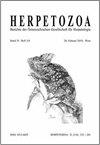Relative clutch mass of Basiliscus vittatus Wiegmann, 1828 (Squamata, Corytophanidae): female morphological constraints
IF 0.9
4区 生物学
Q3 ZOOLOGY
引用次数: 2
Abstract
Clutch size (CS) and relative clutch mass (RCM) are considered important features in life history descriptions of species within Squamata. Variations in these two characteristics are caused by both biotic and abiotic factors. The present study provides the first account related to CS and RCM ofBasiliscus vittatusin Mexico within a population that inhabits an open riverbed juxtapositioned to tropical rainforest habitat in Catemaco, Veracruz, Mexico (170 m a.s.l.). Twenty-nine gravid females were collected and kept in captivity under favorable conditions that promote oviposition. The CS within this population was 6.2 ± 0.2 and was correlated positively with snout vent-length (SVL); while the RCM was 0.17 ± 0.006 and was correlated positively with both CS and width of egg. Factors, such as female morphology and environmental conditions, should influence these reproductive traits inB. vittatus. The data collected in this study could provide a framework for comparisons of the life history traits across populations ofB. vittatusin Mexico and within other species of the family Corytophanidae and provide a model for testing how abiotic and biotic factors may influence the CS and RCM in basilisk lizards throughout their range.维格曼巴西木的相对离合器质量,1828(角鲨目,珊瑚虫科):雌性形态限制
离合器大小(CS)和相对离合器质量(RCM)被认为是角鲨目物种生活史描述的重要特征。这两个特征的变化是由生物和非生物因素共同造成的。本研究首次对墨西哥韦拉克鲁斯州Catemaco(海拔170米)一个与热带雨林栖息地毗邻的开放河床上的种群中的巴西白蠊的CS和RCM进行了描述。收集了29只怀孕的雌性,并将其圈养在有利的条件下,以促进产卵。该群体的CS为6.2±0.2,与口鼻部通气口长度(SVL)呈正相关;RCM为0.17±0.006,与CS和蛋宽呈正相关。雌性形态和环境条件等因素应该会影响B的这些生殖特征。vittatus。这项研究中收集的数据可以为B种群的生活史特征的比较提供一个框架。vittatusin Mexico和珊瑚虫科的其他物种,并为测试非生物和生物因素如何在其整个范围内影响巴西盘蜥的CS和RCM提供了一个模型。
本文章由计算机程序翻译,如有差异,请以英文原文为准。
求助全文
约1分钟内获得全文
求助全文

 求助内容:
求助内容: 应助结果提醒方式:
应助结果提醒方式:


